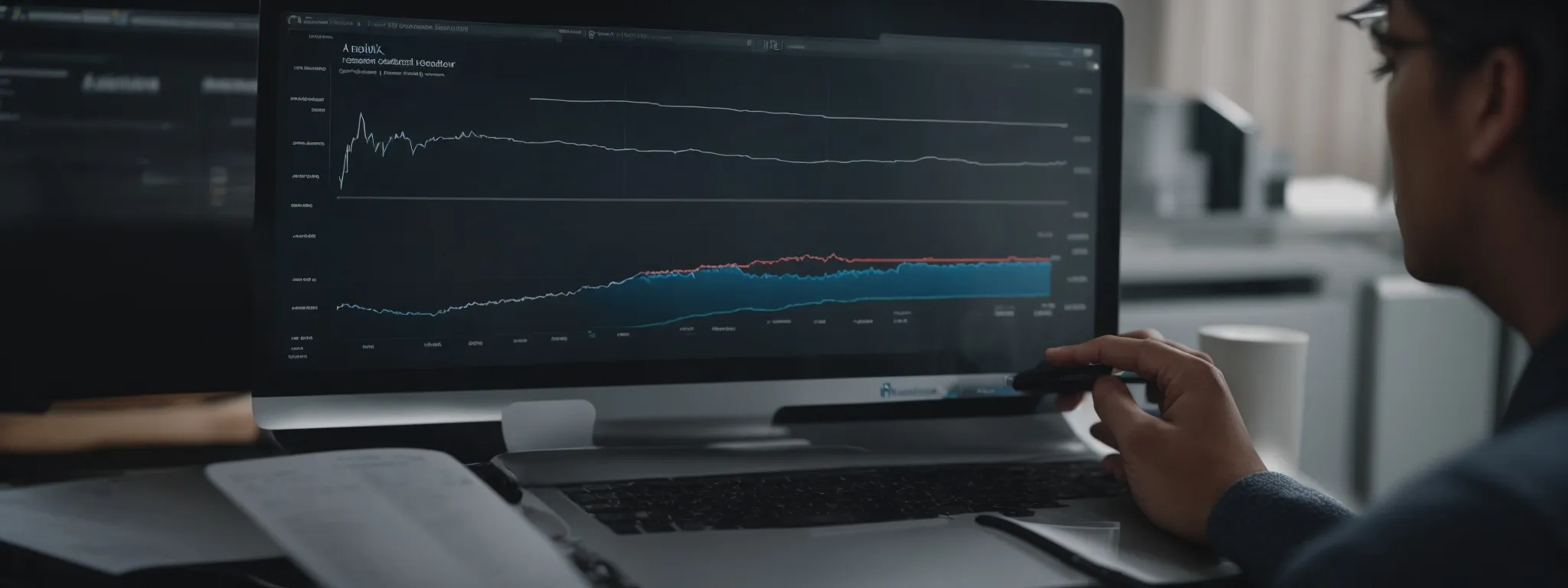SEO Reporting: Metrics and Insights
Mastering SEO Reporting: Key Metrics and Insights for Success In the competitive arena of digital marketing, Search Engine Optimization stands as a vital component for ensuring the […]
Mastering SEO Reporting: Key Metrics and Insights for Success
In the competitive arena of digital marketing, Search Engine Optimization stands as a vital component for ensuring the visibility and success of an organization’s online presence.
Mastery of SEO reporting is not merely about scrutinizing numbers; it requires the discernment to extract actionable insights and discern the narrative those numbers are telling.
LinkGraph’s expertise in defining key metrics and furnishing insights is instrumental in steering companies toward their target outcomes.
For businesses seeking not only to survive but to thrive in the digital ecosystem, understanding the intricacies of SEO reporting is paramount.
Keep reading to uncover how refining your SEO reporting approach can turn data into strategic advantage.
Key Takeaways
- SEO Reporting Provides Organizations With Crucial Insights for Improving Search Engine Rankings and Content Strategies
- LinkGraph’s Suite of SEO Services and SearchAtlas SEO Software Equip Users With Comprehensive Analytics for Informed Decision-Making
- Precise Backlink Analysis and Management Are Essential for Maintaining a Website’s SEO Health and Authority
- On-Page SEO Services From LinkGraph Enable a Detailed Examination of Content Quality and Page Elements to Enhance SERP Positioning
- Understanding and Measuring the ROI of SEO Activities Empowers Organizations to Demonstrate the Value of Their Search Strategies
Establishing the Essentials of SEO Reporting

Within the realm of Search Engine Optimization, determining the efficacy of strategies hinges on the astuteness of SEO reporting.
This critical component supplies organizations with the insights required to understand their current position in search engine result pages.
It offers a clear picture of which tactics are flourishing and which require refinement.
Central to this process is recognizing the purpose of SEO reporting, a step that serves as a foundation for aligning tactics with the company’s aspirations.
Key elements involve defining precise goals and objectives for an SEO campaign, pinpointing the recipient of these reports to ensure data relevancy, and the selection of sophisticated tools designed to dissect and communicate the nuances of SEO performance.
All of these facets coalesce to empower strategists with the capacity to optimize their online presence effectively and efficiently.
Understanding the Purpose of SEO Reporting
Delving into the purpose of SEO reporting involves a thorough examination of outcome-driving metrics that lead to informed decision making. A robust SEO report illuminates the path to improved rankings, identifies traffic trends, and exposes the strengths and weaknesses of content strategies.
SEO reporting operates as a compass guiding companies through the intricate landscape of digital marketing. This strategic instrument aligns the organization’s online efforts with business outcomes, fostering a culture of data-driven optimization.
| SEO Reporting Element | Insights Provided | Business Impact |
|---|---|---|
| Ranking Performance | Capture of keyword positions and visibility | Directs content refinement and keyword strategy |
| Traffic Trends | Analysis of user engagement and sources | Enhances marketing efforts and audience targeting |
| Content Effectiveness | Assessment of page-level metrics for engagement | Sharpens the development of an SEO content strategy |
Defining Your SEO Goals and Objectives
To embark on a successful SEO campaign, it is imperative for a company to outline its objectives with precision. Establishing specific, measurable goals not only steers the direction of SEO efforts but also aids in benchmarking progress and success.
Whether an entity aims to enhance its local SEO footprint, increase organic traffic, or bolster domain authority through white-label link building, setting clear and achievable targets provides a framework for the continuous assessment and adaptation of SEO strategies.
Identifying Your Target Audience for Reports
Identifying the appropriate audience for SEO reports is pivotal. Each report must resonate with its intended recipients, be they team members focused on strategy, stakeholders invested in outcomes, or clients seeking transparency and understanding of SEO endeavors.
Clarity in communication is crucial; hence, SEO reports should be tailored to the specific needs and comprehension levels of the audience. Reports for technical teams might delve into the minutiae of search algorithms, while executive summaries should be streamlined to encapsulate strategic insights:
- Technical SEO Reports for Web Developers and SEO Specialists.
- Executive Summaries for Company Leadership and Decision-Makers.
- Comprehensive Analytics for Marketing Teams and Content Creators.
Selecting the Right Tools for SEO Reporting
Selecting the appropriate tools for SEO reporting is akin to an artist choosing their palette; with the right array of instruments, one can paint a comprehensive picture of an SEO campaign’s effectiveness. LinkGraph’s SearchAtlas SEO software emerges as an excellent choice for this purpose, providing users with an expansive suite of analytics that demystify search engine data.
Effective tools go beyond mere data compilation; they offer actionable insights and user-friendly interfaces that enable companies to extrapolate meaning from complex information. With features that facilitate the necessary reporting requirements—from explore backlink analysis to on-page SEO services—LinkGraph’s white-label SEO services equip users with the capacity to translate raw data into strategic intelligence.
Tracking and Analyzing Organic Traffic Data

As the cornerstone of any refined SEO strategy, monitoring organic traffic yields rich insights into a website’s health and the success of current optimization efforts.
Properly setting up Google Analytics paves the way for an in-depth understanding of SEO insights by capturing vital data related to traffic patterns and sources.
Analyzing user behavior, including bounce rates, becomes indispensable in gauging the significance of content and its ability to engage visitors.
Furthermore, segmenting traffic facilitates meticulous analysis, allowing organizations to discern and cater to the nuanced interests of different audience segments.
In the increasingly competitive digital landscape, these analytical processes are paramount for businesses striving to sustain and amplify their online visibility and performance.
Setting Up Google Analytics for SEO Insights
Setting up Google Analytics is a critical step in harnessing the full potential of SEO insights. This platform captures comprehensive data on organic search traffic, serving as a linchpin for assessing the reach and resonance of a website’s content:
| Google Analytics Metric | Type of Insight |
|---|---|
| User Acquisition | Where visitors originate from, highlighting the performance of organic search |
| Behavior Flow | Visitor navigation through the site, showcasing user engagement and content effectiveness |
By integrating Google Analytics, professionals can discern individual page performance and user behavior, enabling LinkGraph’s clients to refine on-page SEO services. It creates a robust foundation for an SEO content strategy primed for digital marketplace success.
Interpreting Traffic Patterns and Sources
Organic traffic analysis stands as a testament to an organization’s digital pull, manifesting the health of its SEO efforts and the resonance of its content with the consumer base. By decoding the origin and behavior of traffic, companies can pinpoint successful strategies and identify opportunities for further growth.
LinkGraph’s sophisticated tools aid businesses in sifting through traffic data, thereby spotlighting the search patterns that indicate a strong user interest in their products and services. These insights are crucial for crafting targeted SEO initiatives that resonate with the desired audience:
| Traffic Metric | Insight Gathered | Impact on SEO Strategy |
|---|---|---|
| Organic Search Traffic | Insights on user queries leading to the site | Refines keyword targeting and content alignment |
| New vs. Returning Visitors | Understanding of audience loyalty and retention | Adjustments to user engagement and re-targeting efforts |
Analyzing User Behavior and Bounce Rate
Analyzing user behavior, especially bounce rate, is pivotal in understanding how visitors interact with a site. These metrics reveal the enticement of specific pages and the quality of user experience, shaping a narrative for on-site behavior that extends beyond the initial click-through.
Bounce rate reflects the percentage of single-page sessions, a key indicator of page relevancy and engagement. A high bounce rate may signal that a page is not meeting the expectations of visitors or that the user journey is not effectively optimized.
| Metric | Definition | Implications for SEO |
|---|---|---|
| User Behavior | Actions taken by users on a site, like time on page, pages per session | Insights into content effectiveness and user satisfaction |
| Bounce Rate | Percentage of sessions where the user left the site from the entrance page without interaction | Indicator of page relevancy and can influence rankings in search engine results |
Segmenting Traffic for Deeper Analysis
Segmenting traffic is an analytical technique that permits organizations to unravel the complex fabric of their digital audience. By breaking down traffic based on various criteria such as demographics, behavior, or source, companies employ a granular approach to understanding distinct user groups.
Through segmenting, LinkGraph enables its clients to discern specific patterns and preferences, equipping them with the insights needed to tailor their SEO and content strategies to the most receptive segments, thus optimizing the effectiveness of their digital marketing campaigns.
The Importance of Keyword Performance Metrics

At the epicenter of any Search Engine Optimization strategy lies the critical task of keyword management, where monitoring and analyzing keyword performance can dramatically steer a campaign towards success.
Evaluating the resonance of an organization’s core keyword set is not merely about tracking rankings; it is also about digging into the undercurrents that define the visible peaks of search engine results.
For companies leaning into the power of SEO, the focus on deciphering the intricate web spun by keyword metrics is fundamental.
It involves a meticulous process of tracking rankings, scrutinizing keyword trends, and measuring the tangible impact these keywords have in converting visitors into customers.
This refined approach, underpinned by data, drives informed decisions that optimize digital content strategy and enhance the customer journey online.
Identifying Your Core Keyword Set
Pinpointing the primary keywords pivotal to a business’s online growth necessitates a thoughtful and strategic process. LinkGraph’s meticulously crafted SEO services underscore the significance of a core keyword set that aligns with the user’s search intent and the company’s objectives, thereby setting the stage for heightened online visibility and engagement.
Employing sophisticated analysis tools, LinkGraph helps clients distill their broad market into concentrated keywords with the power to attract and convert their target audience. This precision in selection and subsequent monitoring of keyword performance forms the backbone of a formidable SEO content strategy that drives meaningful digital success.
Monitoring Keyword Rankings and Visibility
Aligning a company’s SEO endeavors with the fluctuating dynamics of search engine rankings requires periodic scrutiny of keyword rankings and visibility. LinkGraph’s SEO Services facilitate this by positioning organizations to actively track the placement of their keywords, enabling them to identify trends and capitalize on opportunities for improved search visibility.
Vigilant monitoring of keyword rankings ushers in a heightened awareness of a domain’s traction in search engine results pages (SERPs), which is indispensable for adapting SEO strategies in real-time. LinkGraph’s dedicated tools empower clients to gauge the visibility of their targeted keywords, informing strategic adjustments and ensuring their digital content remains competitive and visible to potential customers.
Analyzing Keyword Trends and Changes
As the digital terrain evolves, so do the trends that dictate keyword effectiveness. LinkGraph’s experts scrutinize these shifts, understanding that what drives traffic today may not hold the same power tomorrow. In scrutinizing these keyword trends, the team provides a narrative that not only captures the present but also anticipates future directions in search behavior.
Changes in keyword performance offer a barometer for the relevance of an organization’s online content. The seasoned professionals at LinkGraph use this dynamic data to carve out adaptive SEO strategies that remain ahead of search engine algorithms, fostering sustained online prominence and authority for their clients.
Evaluating the Impact of Keywords on Conversions
Evaluating the impact of keywords on conversions involves a penetrating look at the nexus between search terms and user actions. This juncture is critical for understanding how effectively a company’s targeted keywords drive not only traffic but also how that traffic contributes to the bottom line through goal completions and conversions. LinkGraph excels in its capacity to distill this data, providing organizations with a clear vision of what keywords are genuine assets in their marketing arsenal.
LinkGraph’s approach zeroes in on the transformative power of keywords to serve as catalysts for customer engagement and sales. Through meticulous tracking and analysis, a correlation emerges between strategically chosen keywords and the rate at which inquiries or clicks translate into tangible business outcomes. Such insights offer a compass for refining a company’s SEO strategy, ensuring an ongoing alignment with consumer search behavior and purchasing habits.
Delving Into Backlink Profile Assessment

Scouring the depth of backlink profiles offers a glimpse into the bedrock of a website’s search engine standing; where each inbound link functions as a nod of confidence from other online entities.
As companies marshal the tides of their SEO performance, mastering the surveillance and assessment of their backlink inventory is non-negotiable.
From diligently choosing tools that keep tabs on backlinks to evaluating the potency and volume of those links, the intricacies of backlink analysis chart a course towards elevating a website’s authority.
Critical to this strategic endeavor is LinkGraph’s SEO services, which offer impeccable insight into the realm of backlink quality and enable organizations to pinpoint invaluable links while dispelling those that tarnish their digital reputation.
These efforts, centered around the judicious management of inbound connections, not only trim the sails of an SEO strategy but also ensure a sturdy vessel capable of navigating the exigent seas of the internet.
Tools for Monitoring Your Backlink Profile
Choosing the right tools to monitor a backlink profile is paramount for any SEO strategy. LinkGraph’s SEO services incorporate sophisticated software, such as their SearchAtlas SEO Tool, designed to provide comprehensive insights into a website’s backlink quality and profile.
Through this facility, organizations can uncover granular details regarding their backlinks, a crucial element in constructing a solid online reputation and improving search engine results. The vigilant analysis enabled by this software assists in distinguishing beneficial links from those which could potentially hinder SEO performance.
| Backlink Monitoring Feature | Benefits |
|---|---|
| Backlink Quality Analysis | Evaluates the caliber of inbound links to enhance SEO value |
| Profile Growth Tracking | Monitors the expansion of backlink profiles over time |
| Toxic Link Identification | Identifies and helps neutralize harmful links |
Understanding the Quality and Quantity of Backlinks
Grasping the caliber and scope of backlinks is a nuanced endeavor, requiring a discerning eye for the attributes that contribute to a website’s SEO prowess. High-quality backlinks from reputable sources act as endorsements, enhancing a company’s credibility in the algorithmic eyes of search engines, while a greater number of these quality links can amplify a site’s authority.
Conversely, LinkGraph recognizes that a surplus of links from dubious sources can be detrimental, prompting professionals to not only assess the quantity but also to scrutinize each backlink’s influence on search engine performance. This critical evaluation is integral, as it shapes the course of actions for fortifying an organization’s link building strategy and search engine standing.
Assessing the Value of Inbound Links
Assessing the value of inbound links is essential for gauging their contribution to a domain’s search engine authority. LinkGraph leverages cutting-edge tools to meticulously evaluate the significance of each link, separating those that bolster authority from those that may pass on negligible or negative equity.
With precision, LinkGraph’s expertise in backlink analysis enables the discernment of the true impact of incoming links on a site’s SEO standing, ensuring clients can capitalize on the links that matter, and address or disavow those that could potentially impair their search rankings.
Strategies for Cleaning Up Bad Links
Cleansing a website of detrimental backlinks constitutes a pivotal strategy in maintaining SEO health and rankings. LinkGraph is adept at identifying and eliminating harmful backlinks that could lead to penalties or a loss of search engine trust.
LinkGraph engages in proactive disavowal practices, enabling clients to indicate to search engines which links should not be considered in the site’s ranking. This surgical removal of undesirable backlinks is a prime example of the company’s commitment to purifying and protecting a client’s online integrity.
Utilizing on-Page SEO Metrics for Better Content

In the artistry of sculpting an online presence, on-page SEO metrics serve as the chisel, shaping the effectiveness of a website’s content and usability.
Professionals meticulously monitor page load speed and mobile usability, scrutinize the efficacy of URL structures and meta tags, and probe the depth of content quality and user engagement.
Furthermore, they assess the influence of on-page elements on search engine results page (SERP) rankings, a meticulous process that fine-tunes the digital face of a brand, ensuring it speaks eloquently to both search algorithms and prospective audiences.
Monitoring Page Load Speed and Mobile Usability
In the pursuit of SEO excellence, monitoring page load speed and mobile usability stands as a non-negotiable benchmark for vitality. A swift page response ensures engagement and diminishes bounce rates, while mobile usability confirms accessibility across a range of devices, catering to the vast mobile audience.
Page load speed and mobile usability are critical metrics that can significantly influence an organization’s SERP position and user satisfaction. Enhanced page speed bolsters user experience and augments SERP ranking potential, while mobile optimization ensures a seamless interaction for users on-the-go: an indispensable aspect in today’s mobile-centric world.
| Metric | SEO Impact |
|---|---|
| Page Load Speed | Influences bounce rates and user experience, critical for SERP ranking |
| Mobile Usability | Ensures accessibility on mobile devices, essential for reaching mobile users and improving SERP rank |
Tracking URL Optimization and Meta Tags Efficiency
URL optimization plays a pivotal role in enhancing search engine understanding and user experience, while meta tags provide succinct previews that influence click-through rates. Crafting URLs with clarity and structure alongside meta descriptions that encapsulate content relevance facilitates ease of indexing by search engines, thereby improving SERP visibility.
LinkGraph’s Comprehensive on-Page SEO Services enable meticulous analysis and refinement of URL optimization and meta tags, ensuring that both elements efficiently contribute to the overarching SEO content strategy. This optimization leads to improved organic reach and engagement, anchoring stronger footholds in competitive digital landscapes.
Analyzing Content Quality and Engagement Metrics
Analyzing content quality and engagement metrics is a sophisticated endeavor, as these indices are indicators of both relevance and resonance with an audience. The assessment becomes a cornerstone for LinkGraph’s on-page SEO services, shaping a narrative around how content meets user needs and preferences.
Depth of content, along with metrics such as time spent on page and interactions per visit, tells a compelling story about how effectively a company’s message captivates its audience. Engagement metrics reflect user behavior and satisfaction levels, serving as a guidepost for enhancing content strategy and optimizing user experience:
| Quality Metric | Engagement Metric | SEO Implications |
|---|---|---|
| Comprehensiveness of topic coverage | Time spent on page | Signals content value and user interest to search engines |
| Usefulness and relevance of information | Pages per session | Indicates user engagement and can reduce bounce rate |
| Accuracy and freshness of content | Interaction rate (comments, shares) | Enhances user interaction, potentially improving rankings |
The consistent measurement and analysis of content quality and engagement inform the refinement of on-page elements, aligning them more closely with user search intent and improving SERP rankings for the company’s key offerings—results that are central to LinkGraph’s commitment to mastering SEO excellence.
Assessing the Impact of on-Page Elements on SERP Positions
Assessing the impact of on-page elements on a website’s position in search engine results pages (SERPs) is a process steeped in analytics. LinkGraph’s on-page SEO services scrutinize the complexities of elements like title tags, heading structure, and internal linking strategies, which are instrumental in communicating content relevance and authority to search engines.
Each on-page factor is meticulously evaluated to ensure that it contributes positively to a site’s SERP standing, enabling businesses to achieve the visibility needed to attract their target audience. The nuanced analysis conducted by LinkGraph aims to turn every webpage into a beacon, signaling its merit to search algorithms and users alike:
- Title tags optimized for keyword relevance and click-through rates.
- Heading structures that delineate content, enhancing readability for algorithms and users.
- Internal linking strategies that reinforce topic clusters and improve site navigation.
Reporting on Conversion Metrics and SEO ROI

In the realm of digital marketing, the significance of conversion metrics and the return on investment (ROI) from SEO activities cannot be overstated.
Mastery of these elements arms organizations with the ability to measure the direct impact of their online strategies.
By setting up conversion tracking within analytics platforms, companies gain clarity on how users transition from casual browsers to committed customers.
Understanding the intricacies of user journeys and conversion paths delivers actionable insights that refine the strategic approach to SEO.
Meanwhile, a rigorous approach to calculating SEO ROI quantifies the tangible benefits accruing from these endeavors, highlighting the true value of search engine optimization efforts.
Capturing and presenting this data in a format that resonates with stakeholders further underscores the critical role SEO plays in achieving business objectives.
Together, these metrics form the cornerstones of a comprehensive and persuasive narrative that showcases the efficacy of SEO investments to all vested parties.
Setting Up Conversion Tracking in Analytics Platforms
Initiating conversion tracking within analytics platforms is a Meticulous Process Crucial for delineating the pathway from user engagement to definitive action. By embedding specific tracking codes on a website’s conversion points, such as contact forms, checkout pages, or sign-up buttons, businesses can capture and analyze the flow of conversions, tracing them back to their SEO efforts.
The precise configuration of conversion tracking not only yields insights into conversion volume but also sheds light on conversion value, offering a deeper understanding of ROI. Discerning the efficacy of various SEO initiatives becomes a streamlined endeavor, as each tracked conversion ties directly to the strategic maneuvers behind traffic acquisition:
- Insights into conversion trends tied to specific SEO actions.
- Identification of high-performing keywords and content that drive conversions.
- Evaluation of user behavior leading up to the conversion event.
Understanding User Journeys and Conversion Paths
In grasping the essence of user journeys and conversion paths, LinkGraph’s analytics reveal the narrative of visitor interactions from the first click to the final conversion. It is this mapping of the voyage that uncovers the digital touchpoints most influential in shifting a visitor from awareness to action, ensuring that each step of their experience is optimized for conversion.
LinkGraph provides an insightful dissection of conversion paths, which illuminates how distinct marketing channels and SEO tactics converge to guide a prospect through the sales funnel. The revelations drawn from such analyses enable optimization of the user journey, ultimately refining the path toward increased conversions and a robust SEO ROI.
Calculating SEO Return on Investment
Calculating SEO Return on Investment (ROI) is an analytical exercise that fundamentally ties the fiscal impact of SEO efforts to a company’s bottom line. LinkGraph Expertly Quantifies This ROI by correlating increased revenue streams obtained through organic search rankings with the investment injected into SEO activities.
LinkGraph’s nuanced approach in measuring SEO ROI illuminates the financial efficiencies honed by search optimization, allowing organizations to comprehend the profitability of their SEO strategies. This calculation encapsulates not only the direct revenue generated but also encompasses the diminished costs of acquisition, shining a light on the strategic value SEO lends to sustainable business growth.
Presenting Data to Stakeholders to Reflect SEO Value
Presenting data to stakeholders is a strategic exercise whereby the abstract becomes tangible, and the numerical gains a narrative. Through this lens, LinkGraph transforms intricate SEO datasets into compelling reports that articulate the profound impact of SEO on business objectives, relaying to investors, executives, and team members the concrete value derived from strategic search engine optimization initiatives.
LinkGraph’s experts tailor communication to resonate with the stakeholders’ level of SEO expertise, ensuring every presentation becomes an enlightening reflection of SEO’s contribution to improved traffic, enhanced brand visibility, and the resulting commercial growth. This targeted articulation aids stakeholders in recognizing the full spectrum of SEO’s long-term benefits, offering clarity on the imperative role SEO plays within the broader scope of the company’s digital marketing strategy.
Conclusion
Mastering SEO reporting is essential for the success of any digital marketing strategy.
By setting clear goals, recognizing the intended audience, and choosing sophisticated tools like LinkGraph’s SearchAtlas, businesses gain vital insights to refine tactics and align with company aspirations.
Monitoring organic traffic and user behavior through platforms such as Google Analytics reveals the health of SEO efforts, while understanding and segmenting traffic data informs targeted initiatives.
Additionally, careful management of keyword performance metrics, including monitoring rankings and evaluating the impact on conversions, drives informed decisions that optimize digital content strategy.
Backlink profile assessment, including monitoring and cleaning up bad links, is crucial for maintaining SEO health and domain authority.
On-page SEO metrics inform content quality and engagement, influencing SERP positions.
Lastly, tracking conversion metrics and calculating SEO ROI are imperative for demonstrating the concrete value of SEO campaigns, ensuring stakeholders understand the impact of SEO on achieving business objectives.















































































